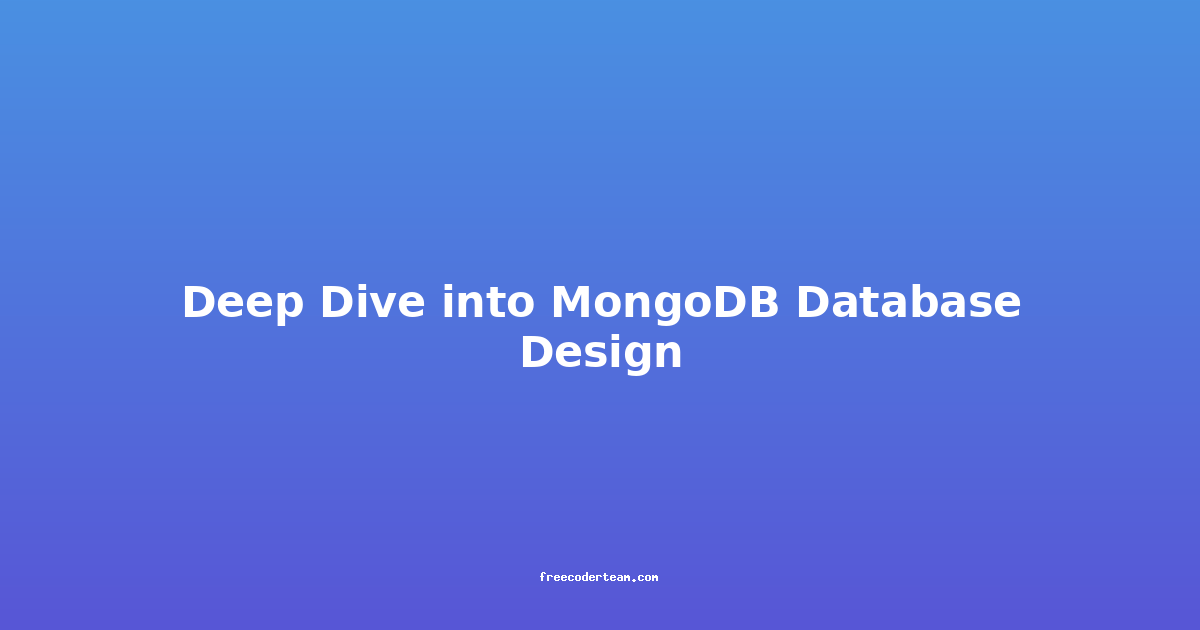Deep Dive into MongoDB Database Design: Best Practices, Insights, and Practical Examples
MongoDB is a popular NoSQL database known for its flexibility, scalability, and ability to handle unstructured data. However, designing an effective MongoDB schema requires careful consideration to optimize performance, ensure data integrity, and support your application's needs. In this blog post, we'll explore best practices, actionable insights, and practical examples to help you design a robust MongoDB database.
Table of Contents
- Understanding MongoDB Data Modeling
- Key Concepts in MongoDB Design
- Design Patterns in MongoDB
- Best Practices for MongoDB Schema Design
- Practical Example: Designing a User-Centric Application
- Conclusion
Understanding MongoDB Data Modeling
MongoDB stores data in documents, which are similar to JSON objects. These documents can have nested structures and can vary in fields. Unlike SQL databases, MongoDB doesn't enforce strict schema constraints, allowing for flexible data modeling. This flexibility is both a strength and a challenge, as it requires careful planning to avoid inefficiencies.
Key Characteristics of MongoDB Documents
- Schema-less: Documents within a collection can have different fields.
- Nested Structures: Documents can contain arrays and subdocuments.
- Dynamic Fields: Fields can be added or removed dynamically.
Key Concepts in MongoDB Design
Before diving into design patterns, it's essential to understand some core concepts:
1. Collections
- Definition: Collections are similar to tables in SQL databases. They group related documents together.
- Best Practice: Keep collections as high-level entities. For example, instead of having separate collections for users and orders, you might embed orders within the user document if they are closely related.
2. Documents
- Definition: Documents are the primary storage unit in MongoDB. They can include fields, subdocuments, and arrays.
- Best Practice: Embed related data within a document when it's accessed together frequently. Use references when the data is accessed independently.
3. Indexes
- Definition: Indexes optimize query performance by allowing MongoDB to locate data more efficiently.
- Best Practice: Always index fields that are frequently used in queries. For example, if you frequently search by
username, create an index on that field.
4. Atomicity
- Definition: MongoDB operations are atomic at the document level. This means that updates to a single document are either fully applied or not applied at all.
- Best Practice: Design your schema to allow updates to be performed on a single document whenever possible.
Design Patterns in MongoDB
MongoDB supports two primary design patterns: Embedded Documents and Referenced Documents. The choice between these patterns depends on your application's access patterns and scalability requirements.
1. Embedded Documents
- When to Use: When data is closely related and accessed together frequently.
- Example: A user document with embedded orders.
{
_id: ObjectId("..."),
username: "john_doe",
email: "john@example.com",
orders: [
{
order_id: "orderid1",
items: ["item1", "item2"],
total: 100,
date: ISODate("2023-01-01T00:00:00Z")
},
{
order_id: "orderid2",
items: ["item3"],
total: 50,
date: ISODate("2023-01-02T00:00:00Z")
}
]
}
- Pros:
- Reduces the number of queries needed to fetch related data.
- Simplifies transactions since all related data is in one document.
- Cons:
- Can lead to large documents if there are many related items.
- Updates to deeply nested fields can be complex.
2. Referenced Documents
- When to Use: When data is frequently updated independently or when there's a need to scale horizontally.
- Example: Separate collections for users and orders with references.
// Users collection
{
_id: ObjectId("..."),
username: "john_doe",
email: "john@example.com"
}
// Orders collection
{
_id: ObjectId("..."),
user_id: ObjectId("..."), // Reference to the user
items: ["item1", "item2"],
total: 100,
date: ISODate("2023-01-01T00:00:00Z")
}
- Pros:
- Better scalability for large datasets.
- Easier to manage independent updates.
- Cons:
- Requires additional queries (joins) to fetch related data.
- More complex transactions.
3. Hybrid Approach
- When to Use: When you need to balance the benefits of both embedded and referenced documents.
- Example: Embed commonly accessed data and reference less frequently accessed data.
// Users collection
{
_id: ObjectId("..."),
username: "john_doe",
email: "john@example.com",
recent_orders: [
{
order_id: "orderid1",
total: 100,
date: ISODate("2023-01-01T00:00:00Z")
},
{
order_id: "orderid2",
total: 50,
date: ISODate("2023-01-02T00:00:00Z")
}
],
all_orders: [ObjectId("..."), ObjectId("...")] // References to orders collection
}
// Orders collection
{
_id: ObjectId("..."),
user_id: ObjectId("..."), // Reference to the user
items: ["item1", "item2"],
total: 100,
date: ISODate("2023-01-01T00:00:00Z")
}
- Pros:
- Balances the trade-offs between embedding and referencing.
- Optimizes for both performance and scalability.
- Cons:
- More complex schema design.
Best Practices for MongoDB Schema Design
1. Normalize When Necessary, Denormalize When Useful
- Normalization: Use references to avoid duplicating data.
- Denormalization: Embed related data to reduce the number of queries.
2. Choose the Right Data Type
- Use appropriate data types to optimize storage and query performance. For example:
- Use
ObjectIdfor unique identifiers. - Use
Datefor timestamp fields. - Use
NumberIntorNumberLongfor integers, depending on the size.
- Use
3. Index Frequently Accessed Fields
- Always index fields used in filters, sort operations, or join conditions.
- Use compound indexes for queries that filter on multiple fields.
4. Optimize for Access Patterns
- Design your schema based on how your application accesses data. If you frequently fetch users with their orders, embedding orders might be better. If you often update orders independently, referencing might be more suitable.
5. Limit Document Size
- MongoDB has a 16MB document size limit. Be mindful of this when embedding large amounts of data.
6. Use Subdocuments for Hierarchy
- Use subdocuments to represent hierarchical data, such as addresses or nested configurations.
7. Design for Scalability
- Plan for horizontal scaling by ensuring that your schema can support sharding across multiple nodes.
Practical Example: Designing a User-Centric Application
Let's design a schema for a social media application where users can post updates, follow other users, and like posts.
Requirements:
- Users can create posts.
- Users can follow other users.
- Users can like posts.
- The application needs to fetch a user's recent posts and followers efficiently.
Schema Design:
1. Users Collection
- Fields:
_id: Unique identifier for the user.username: Unique username.email: User's email address.followers: Array of follower IDs.following: Array of IDs of users the current user is following.recent_posts: Array of recent posts embedded within the document.all_posts: Array of references to post IDs.
{
_id: ObjectId("..."),
username: "john_doe",
email: "john@example.com",
followers: [ObjectId("..."), ObjectId("...")],
following: [ObjectId("..."), ObjectId("...")],
recent_posts: [
{
post_id: "postid1",
content: "Hello, world!",
likes: 10,
date: ISODate("2023-01-01T00:00:00Z")
},
{
post_id: "postid2",
content: "Another post!",
likes: 5,
date: ISODate("2023-01-02T00:00:00Z")
}
],
all_posts: [ObjectId("..."), ObjectId("...")]
}
2. Posts Collection
- Fields:
_id: Unique identifier for the post.user_id: Reference to the user who created the post.content: The post content.likes: Array of user IDs who liked the post.comments: Array of subdocuments representing comments.
{
_id: ObjectId("..."),
user_id: ObjectId("..."), // Reference to the user
content: "This is a post!",
likes: [ObjectId("..."), ObjectId("...")],
comments: [
{
user_id: ObjectId("..."),
comment: "Great post!",
date: ISODate("2023-01-01T00:00:00Z")
}
]
}
Indexes:
- Users Collection:
- Index on
usernamefor fast lookups. - Index on
followersandfollowingif you frequently query based on these fields.
- Index on
- Posts Collection:
- Index on
user_idto fetch posts by a specific user. - Index on
likesif you frequently query based on likes.
- Index on
Query Examples:
-
Get a user's recent posts:
db.users.find( { username: "john_doe" }, { recent_posts: 1 } ) -
Get all posts by a user:
db.posts.find( { user_id: ObjectId("...") }, { content: 1, likes: 1 } ) -
Get a user's followers:
db.users.find( { username: "john_doe" }, { followers: 1 } )
Conclusion
MongoDB's flexible schema design allows you to tailor your database to the needs of your application. By understanding the trade-offs between embedding and referencing, optimizing for access patterns, and leveraging indexes, you can create a robust and efficient MongoDB schema.
Remember:
- Embed when data is closely related and accessed together.
- Reference when data is updated independently or when scalability is a concern.
- Balance between denormalization and normalization based on your application's requirements.
With careful planning and adherence to best practices, you can design a MongoDB database that supports your application's growth and performance needs. Happy coding! 😊
If you have any questions or need further clarification, feel free to ask! 🚀




